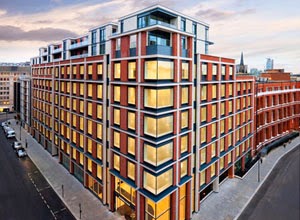Interchange Junctions
5 Howick Place, London
10 May - 21 June 2014
Open Day Saturday 17 May 11am - 5pm
10 May - 21 June 2014
Open Day Saturday 17 May 11am - 5pm
Chapter the first
in which the author freeforms somewhat on a press release,
indulges in some churnalism and pseudo-academic debate
asks questions about the nature of artistic patronage
and ponders the function of capital against religion
Allow me to begin, dear reader, with details from an electronic epistle that I have but recently received. It promises an exhibition of aesthetic splendour that nevertheless flirts like a coquette with many most abstract and portentous ideals.
 HS Projects are delighted to present Interchange Junctions, a group exhibition of internationally established and emerging artists examining ideas of colonialism, post colonialism, slavery, cultural exchange and trade. The exhibition examines contested cultural and political histories which carry special resonance at Howick Place, named after Viscount Howick - later 2nd Earl Grey - one of the main architects of the Reform Act 1832, Catholic emancipation and the abolition of slavery in the British Empire.
HS Projects are delighted to present Interchange Junctions, a group exhibition of internationally established and emerging artists examining ideas of colonialism, post colonialism, slavery, cultural exchange and trade. The exhibition examines contested cultural and political histories which carry special resonance at Howick Place, named after Viscount Howick - later 2nd Earl Grey - one of the main architects of the Reform Act 1832, Catholic emancipation and the abolition of slavery in the British Empire.
It is well that such a man should be remembered in our architecture, for The Great Reform Act is part of the architecture that supports the British notion of democratic freedoms - and the non-partisan espousal of both freedom for slaves and enfranchisement for Catholics represents a sharp diversion from the anti-slavery efforts of others, which would often equate popery with enslavement. The words of Lord Shaftesbury spring to mind, in which he names them as 'sisters.'
Yet this next paragraph did draw my attention.
The exhibition has been made possible by Invesco Real Estate (IRE), the global real estate investment manager and new asset manager of 5 Howick Place and Terrace Hill, the joint developer behind the landmark building with Doughty Hanson.
Yet while I do not subscribe to a Marxist idealism that art should be kept free of the stain of capitalist lucre, nor that art is merely an expression of the economic context, I admit a slight pang at so direct an association of commerce with creativity.
This is mere hypocrisy on my part: do I not often thrill at those Renaissance paintings, funded by the aristocrats or the church, which would have arguably been better spent on those compassionate works enjoined by Christ? And the more contemporary debate of governmental funding for the fine arts: how many hospitals could have been built with that money?
I am silent on these matters, and my pang at the commercial here is merely knee-jerk sentimentality, a romantic ideal that art may be formed without financial constraint or direction. And the pride of those companies in announcing their support is a reminder, a clarion call, to address the process of capitalist manipulation of aesthetics, the commodification of art into an object of price rather than worth. It is oddly more honest that the pieta that hides the patronage of a church or monastic order in its elegant form.
No comments :
Post a Comment